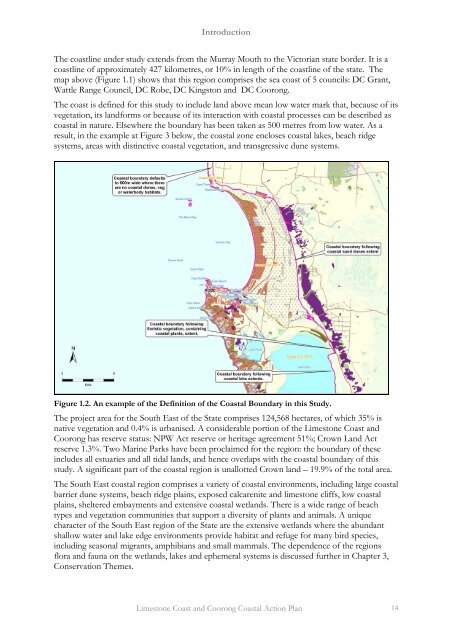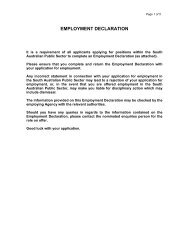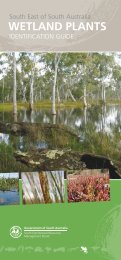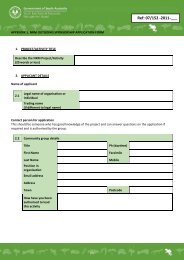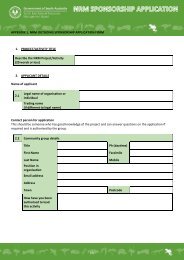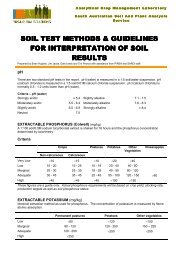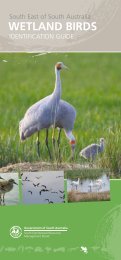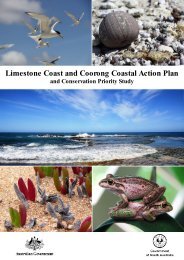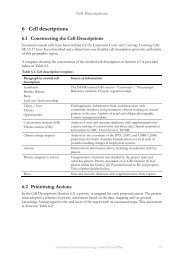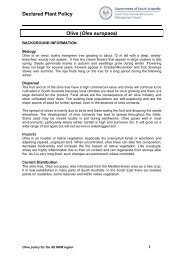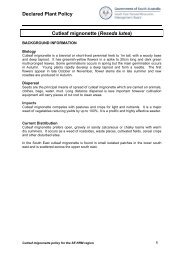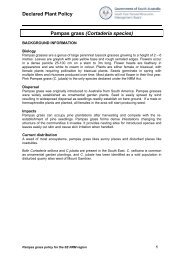Chapter 1 - Introduction - South East Natural Resources ...
Chapter 1 - Introduction - South East Natural Resources ...
Chapter 1 - Introduction - South East Natural Resources ...
Create successful ePaper yourself
Turn your PDF publications into a flip-book with our unique Google optimized e-Paper software.
<strong>Introduction</strong><br />
The coastline under study extends from the Murray Mouth to the Victorian state border. It is a<br />
coastline of approximately 427 kilometres, or 10% in length of the coastline of the state. The<br />
map above (Figure 1.1) shows that this region comprises the sea coast of 5 councils: DC Grant,<br />
Wattle Range Council, DC Robe, DC Kingston and DC Coorong.<br />
The coast is defined for this study to include land above mean low water mark that, because of its<br />
vegetation, its landforms or because of its interaction with coastal processes can be described as<br />
coastal in nature. Elsewhere the boundary has been taken as 500 metres from low water. As a<br />
result, in the example at Figure 3 below, the coastal zone encloses coastal lakes, beach ridge<br />
systems, areas with distinctive coastal vegetation, and transgressive dune systems.<br />
Figure 1.2. An example of the Definition of the Coastal Boundary in this Study.<br />
The project area for the <strong>South</strong> <strong>East</strong> of the State comprises 124,568 hectares, of which 35% is<br />
native vegetation and 0.4% is urbanised. A considerable portion of the Limestone Coast and<br />
Coorong has reserve status: NPW Act reserve or heritage agreement 51%; Crown Land Act<br />
reserve 1.3%. Two Marine Parks have been proclaimed for the region: the boundary of these<br />
includes all estuaries and all tidal lands, and hence overlaps with the coastal boundary of this<br />
study. A significant part of the coastal region is unallotted Crown land – 19.9% of the total area.<br />
The <strong>South</strong> <strong>East</strong> coastal region comprises a variety of coastal environments, including large coastal<br />
barrier dune systems, beach ridge plains, exposed calcarenite and limestone cliffs, low coastal<br />
plains, sheltered embayments and extensive coastal wetlands. There is a wide range of beach<br />
types and vegetation communities that support a diversity of plants and animals. A unique<br />
character of the <strong>South</strong> <strong>East</strong> region of the State are the extensive wetlands where the abundant<br />
shallow water and lake edge environments provide habitat and refuge for many bird species,<br />
including seasonal migrants, amphibians and small mammals. The dependence of the regions<br />
flora and fauna on the wetlands, lakes and ephemeral systems is discussed further in <strong>Chapter</strong> 3,<br />
Conservation Themes.<br />
Limestone Coast and Coorong Coastal Action Plan 14


